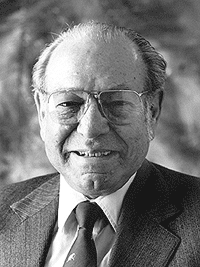Dorian Shainin | |
|---|---|
 | |
| Born | September 26, 1914 San Francisco, California |
| Died | January 7, 2000 (aged 85) |
| Nationality | American |
| Alma mater | Massachusetts Institute of Technology |
| Known for | Red X |
| Awards | The American Society for Quality's Brumbaugh Award (1951), the Edwards Medal (1969), the Eugene L. Grant Award (1981), and the Shewhart Medal (1989) |
| Scientific career | |
| Fields | Reliability engineering, Acceptance sampling |
| Institutions | United Aircraft Corporation, Grumman Aerospace, Shainin LLC |
Dorian Shainin (September 26, 1914 – January 7, 2000) was an American quality consultant, aeronautics engineer, author, and college professor most notable for his contributions in the fields of industrial problem solving, product reliability, and quality engineering, particularly the creation and development of the "Red X" concept.[1]
Shainin (pronounced SHAY-nin), founder of the technical-problem-solving company Shainin LLC, is responsible for the development of over 20 statistical engineering techniques that have become the core of the "Shainin System" for quality and reliability improvement.[2]
Throughout his life, Dorian Shainin worked to improve the quality and reliability of an array of products, including paper, printing, textiles, rubber, nuclear energy, airplanes, automobiles, cassette decks, space ships, light bulbs and disposable diapers,[3] with clients representing over 200 different industries, ranging from the U.S. Department of Defense, Rolls-Royce Ltd. and Exxon to Polaroid, Hewlett-Packard, AT&T and Ford Motor. In total, Shainin advised over 800 companies, 43 of which were among the Fortune 100.[4]
- ^ Ingle, Sud, In Search of Perfection: How to Create/maintain/improve Quality, Prentice-Hall, 1985, p. 47, ISBN 0-13-467556-8
- ^ IPC Business Press, Quality Today: Measurement & Inspection Technology, IPC Industrial Press, 1994, p. 25
- ^ Rath & Strong Management Consultants, from In This Issue, 1957 Harvard Business Review, "Dorian Shainin" Archived October 16, 2006, at the Wayback Machine
- ^ Bhote, Keki, The Power of Ultimate Six SIGMA, Amacom, New York, 2003, p. 15, ISBN 0-8144-0759-5